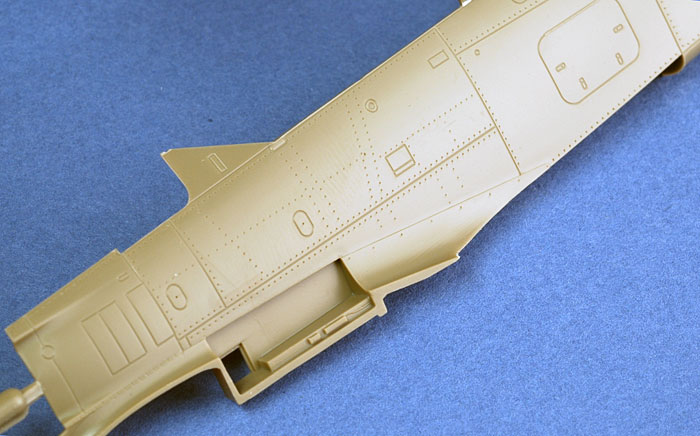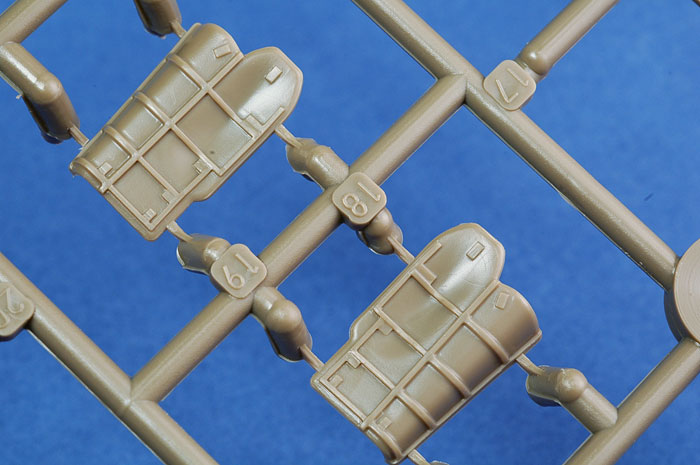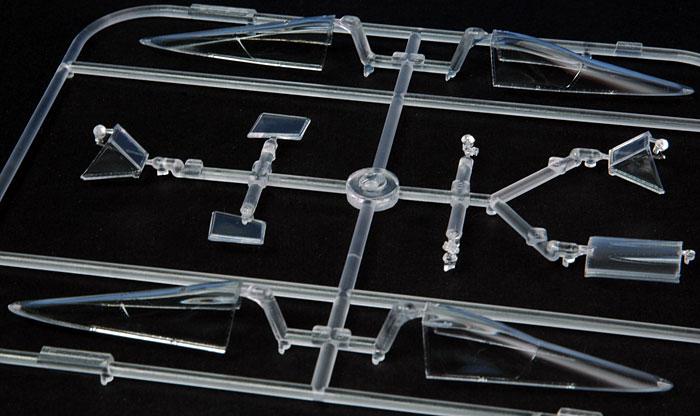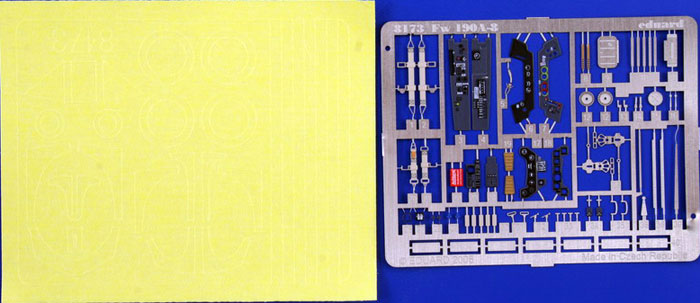|
Focke-Wulf Fw 190 A-8

Eduard, 1/48 scale
S
u m m a r y
|
| Catalogue Number: |
Eduard Kit No. 8173 - Focke-Wulf Fw
190 A-8 |
| Scale: |
1/48 |
| Contents and Media: |
172 parts in olive coloured plastic;
8 parts in clear; colour photo-etched fret; masking sheet; markings for four aircraft. |
| Price: |
USD$39.95 plus shipping
available online from Eduard
Free shipping on orders of more than USD$80.00 |
| Review Type: |
FirstLook |
| Advantages: |
Beautifully detailed including full
engine and gun bays; superbly restrained surface
featuring crisp panel lines and very fine lines of recessed rivets where
appropriate; engineered without plugs/inserts; wing cannon access hatch
not split along wing root join; plenty of ordnance options including
drop tank, bomb, W.Gr.21 mortars (rockets); intriguing extra parts
(labeled as "not for use" here) such as broad prop blades and 14 bladed
fan for A-9/F-9 versions, canopy side armour and plugged gun troughs for
R-2/R-8, short centreline rack for A-6 and earlier; includes colour photo-etched parts for harness and
instrument panel, and masks for wheels and canopies; clever design of
clear parts with separate sliding sections for open and closed canopies; attractive marking options;
blown and standard hood included; very high quality
plastic; narrow sprue attachments; excellent instructions and packaging. |
| Disadvantages: |
|
| Recommendation: |
Highly Recommended |
Reviewed by Brett Green

Eduard's 1/48 scale Focke-Wulf Fw 190 A-8 will
be available online from Squadron.com
Dateline, 2002. Modellers have the choice of two
nice 1/48 scale P-47D Thunderbolt kits, one from Hasegawa and one from
Academy. Although a few years old, both are adequately detailed and
reasonably accurate representations of the type. Tamiya surprises
everybody by announcing their own new tool 1/48 scale Thunderbolt
family. The prevailing opinion following the announcement was, why would
Tamiya bother to duplicate this subject when two decent kits are already
available?
This skepticism was silenced with a kit that set
new standards in detail, engineering and fit. Tamiya's effort far
exceeded any P-47 kit released to that time, and modellers were grateful
for this new generation of Thunderbolts.
Fast forward to 2006. Eduard announces a new tool
1/48 scale Focke-Wulf Fw 190 family. Modellers currently have the choice
of the old but accurate Dragon Würger family; a newer (and very nice)
Hasegawa Fw 190 A-3/4; and the easy to build but somewhat flawed Tamiya
kits.
There can be no doubt that the Focke-Wulf Fw 190
is one of the most popular modelling subjects in history and, similar to
Tamiya in 2002, Eduard has obviously decided to take this subject to a
new level.
Eduard's 1/48 scale Focke-Wulf Fw 190 A-8
comprises 172 parts in olive coloured plastic; 8 parts in clear; a
colour photo-etched fret; masking sheet; and a colourful decal sheet
with markings for four aircraft..

Click
the thumbnails below to view larger images:
The kit is state of the art in terms of quality of
injection moulded parts, detail and markings.
Eduard's packaging is very modeller-friendly. Sprues are packed,
singly or in pairs, in resealable bags with each pair of sprues
interlocked to prevent scuffing.
The styrene parts are attached to seven sprues via fine connectors.
Moulding quality is superb. I could not find a single sink mark or
ejector pin anywhere that will be visible on the finished model, even in
problematic areas such as the inside of cowlings, undercarriage covers
and the gear bay. Small locating pins are moulded to parts as required.
You might be able to see some very fine flash around a few detail parts
in these sprue photos, but this is an attribute of the test shots and
will not be present on the production kits.
Surface detail is excellent. Panel lines are consistent and finely
engraved. Very subtle lines of rivets are also present in logical
locations (on the cowl, along panel line etc). Rivets are a matter of
personal taste, but the finely rendered detail looks terrific to my eye.
Please note that, for the close-up photographs on this page, I have
turned the parts to reflect the light and highlight the rivets. When
viewed under normal light they are very restrained.
Attention to detail is equally impressive. For example, in every
Focke-Wulf Fw 190 kit produced to date, the access hatch for the inboard
wing cannon has a big seam line running in line with the wing root. This
is usually tricky to eliminate. Eduard's kit addresses this challenge
with separate hatches. Not only does this avoid the seam line, but
Eduard also provides gun bay interior detail to permit the hatch to be
posed open. The cowl gun bay is comprehensively detailed too.

Click
the thumbnails below to view larger images:
Also for the first time in a Würger, kit, Eduard supplies a
well-detailed BMW 801 engine including mounts and firewall detail. A
plastic template is supplied to ensure correct alignment of the snaking
exhaust pipes.
The main undercarriage offers the choice of treaded or slick tyres
(both unweighted). Optional tail gear is supplied - either a single
piece (wheel and leg moulded together), or a separate wheel and
two-piece strut.
The rudder and ailerons are moulded as separate parts, so they may be
posed to taste. Elevators are fixed in the neutral position, but it will
be an easy matter to cut these off and reposition if desired.
Cowl flaps are moulded shut, but photo-etched parts are supplied if
the modeler wishes to pose them open.
Two sets of upper wings are supplied. One has the bulged cannon
fairing and the other does not.
Ordnance options include a 300 litre drop tank, a bomb and two
W.Gr.21 mortars (rockets).
The kit is necessarily complex due to the high level of detail, but
it is pleasing to see that Eduard has chosen not to further complicate
construction with plugs and inserts for different versions. For example,
the wings are supplied as pure A-8 wings, with bulges and ejector ports
moulded in place. This will make for a cleaner build with less filler
and frustration.
A number of parts are marked "not for use", including
broad propeller blades and 14 bladed fan for A-9/F-9 versions (we cannot
build an A-9 straight from this box as we are not supplied with the
thicker armoured cowl ring - yet!), canopy side armour and plugged gun
troughs for R-2/R-8 (we will presumably get and all-new wing with MK 108
cannon, plus fuselage armour when this version is released. Also, please
note that production kits do not include some of these options R-2/R-8
options), and the short centreline rack for A-7 and earlier variants.
Indeed, Eduard has already announced that other versions will be
following.
If you just can't wait for an official Eduard version of
a Focke-Wulf Fw 190 A-7, you can easily backdate this kit as follows:
-
Use the short centreline rack (Part K23)
-
Use cowling parts H10, H14 and H26 (these depict the
earlier "two up, one down" top fastener arrangement)
-
Fill the oval hatch under the fuselage (actually on
the trailing edge of the bottom wing, Part E1)
-
Fill one more hatch each on the port and starboard
fuselage side
-
Relocate the fuel filler hatch
-
Relocate the pitot inboard to mid-wing
Check your references for exact locations of hatches and
pitot.
Clear parts emphasize Eduard's innovation. Two styles of
canopy are included - flat and blown - and two of each are attached to
the clear sprue. On the real Würger, the canopy was somewhat flexible.
This flexibility was further enhanced with a short hinge on the top.
This was necessary because the canopy rails tapered inwards back along
the fuselage, requiring the front bottom corners of the canopy to pinch
inward when opening (ie, the width was narrower when the canopy was
open). This attribute has been conveniently ignored by all Fw 190 models
to date - an open canopy would simply overhang the sides of the canopy
deck. Eduard, however, has supplied a closed (wide) and open (narrow)
version for each canopy style. Clever stuff.

The colour photo-etched fret adds useful detail. In
fact, it is impossible to imagine anyone being able to match the realism
of these crisply printed parts with paint.
This fret provides the harness, instrument panel and side consoles in
full colour,
plus supplementary metal detail parts for the cockpit and aircraft
exterior. The instrument panel should look fantastic when assembled,
incorporating all the tiny details of the dials and the characteristic
coloured surrounds of the engine gauges. The colour of the instrument
panel and consoles on my pre-production sample is RLM 02, but the
production kits will have these parts finished in the correct shade of
RLM 66 Black Grey. Eduard has supplied a photo of the corrected PE fret
(below).

Another nice touch is the inclusion of canopy and wheel
masks in Eduard's new, thin flexible yellow masking material. An extra
mask will be included in the production kit, destined for the area under
the open wing root cannon access hatch (parts # I18/I19). This area was
unpainted, so when the hatch was open, the natural metal was exposed.
Instructions are supplied in an A-4 size, stapled colour 16 page booklet,
with a detailed history on the front page followed by a parts list and
ten pages of construction steps and four pages of full-colour marking
guides, each with a four-view illustration.
Markings are provided for four colourful aircraft, all
with different schemes. Decals look to be very
thin and of high quality.

Click
the thumbnails below to view larger images:
Construction Tips from Eduard
As a result of test-building several kits, Eduard has
pointed out several areas requiring special attention during assembly.
These include the following:
-
Check the position of
the completed cockpit interior to the fuselage halves. Especially
the back (upper) part of the cockpit tub must be aligned exactly
with line on the fuselage halves. Also the weapon bay must be
carefully positioned.
-
Another important point
is the wing spar (part I16) installation. In this step (page 5 of
the instructions), first glue part K20 into the wing, and then add
part I16. This sequence will guarantee that the wing spar will be
exactly vertical to the wing bottom. This is crucial for wheel well
assembly and the whole wing geometry.
-
Another sensitive point
is the engine mount installation. In this point, find the exact
position of the part K18 on the reverse (inside of the fuselage)
side of the part H12 (wheel well). K18 fits exactly to the notch in
the H12. If you glue K18 carefully to the given position, the engine
block will easily assume the correct position when it is glued to
the engine mount.
-
The locating holes for
the main wheels are quite large. This is because the wheel fits to
the axle at an angle. Use the instruction picture (page 10) to
determine the exact angle of the wheel to the undercarriage leg.
-
While we are talking
about the undercarriage, when you will assembly the K7 (u/c leg) to
the H1 (u/c cover), the location pins on the leg will give you exact
position of the hatch (H1) to the leg. This is similar to the
assembly of the u/c to the wing – glue the leg to the fine locating
position in the wheel well, and immediately add J30/J37 to the
position in the wheel well and on the u/c leg (there is a fine
location pin on the leg which fits to the small hole on the end of
the tow bar). It will give you exact position of the undercarriage
to the wing. This is a different system compared to other
manufacturers' kits, but it delivers surprisingly good result.
The quality of Eduard's kits has improved vastly over the
last decade. Eduard's new-tool offerings
now rival the best kits from Japan. Indeed, in my opinion, Eduard's overall
detailing and packaging in this model exceed the standards achieved to
date by mainstream model companies.
Over the years, Eduard has answered the prayers of many niche
modellers by offering some less glamorous subjects in 1/48 scale,
including their recent excellent Polikarpov I-16, the Bf 108, Bell X-1,
Ki-115 Tsurugi and a stack of increasingly impressive WWI aircraft kits.
This Focke-Wulf Fw 190 A-8 will now introduce the joys of Eduard to a
broader market.
I know it must seem that I am stretching for superlatives in this
review, but Eduard's Focke-Wulf Fw 190 A-8 is a magnificent kit,
spectacularly detailed and beautifully presented. In the box, it looks
like the best Würger available in any scale (and the recent
Hasegawa 1/32 scale kits take some topping).
Keep in mind, though, that this is not a kit that will fall together
by itself, so you will be advised to allocate plenty of time and treat
it with the respect that it deserves. If you have already assembled a
few kits, however, you should not have any trouble finishing this
wonderful Würger.
Highly Recommended.
Thanks to Eduard for the sample
Review Text Copyright © 2006 by
Brett Green
Page Created 06 October, 2006
Last updated 21 February, 2007
Back to HyperScale Main Page
Back to Reviews Page
|
Home | What's
New | Features
| Gallery |
Reviews | Reference
| Forum
| Search